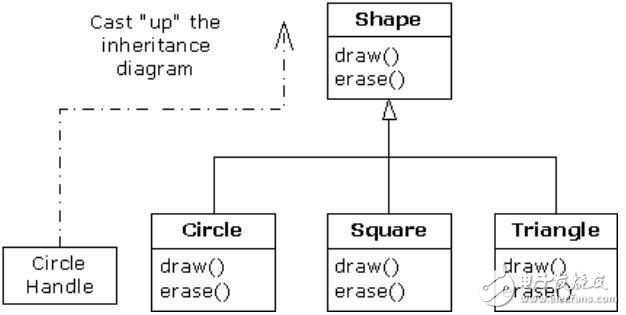Java繼承怎么寫
繼承與合成基本概念
繼承:可以基于已經存在的類構造一個新類。繼承已經存在的類就可以復用這些類的方法和域。在此基礎上,可以添加新的方法和域,從而擴充了類的功能。
合成:在新類里創建原有的對象稱為合成。這種方式可以重復利用現有的代碼而不更改它的形式。
1.繼承的語法
關鍵字extends表明新類派生于一個已經存在的類。已存在的類稱為父類或基類,新類稱為子類或派生類。例如:
類Student繼承了Person,Person類稱為父類或基類,Student類稱為子類或派生類。
2.合成的語法
合成比較簡單,就是在一個類中創建一個已經存在的類。
classStudent{Dogdog; }上溯造型
1.基本概念
繼承的作用在于代碼的復用。由于繼承意味著父類的所有方法亦可在子類中使用,所以發給父類的消息亦可發給衍生類。如果Person類中有一個eat方法,那么Student類中也會有這個方法,這意味著Student對象也是Person的一種類型。
class Person { publicvoideat() { System.out.println( “eat”); } staticvoidshow(Person p) { p.eat(); } } publicclassStudentextendsPerson{publicstaticvoidmain(String[] args) { Student s = newStudent(); Person.show(s); // ①} }
【運行結果】:
eat
在Person中定義的show方法是用來接收Person句柄的,但是在①處接收的卻是Student對象的引用。這是因為Student對象也是Person對象。在show方法中,傳入的句柄(對象的引用)可以是Person對象以及Person的衍生類對象。這種將Student句柄轉換成Person句柄的行為成為上溯造型。
2.為什么要上溯造型
為什么在調用eat是要有意忽略調用它的對象類型呢?如果讓show方法簡單地獲取Student句柄似乎更加直觀易懂,但是那樣會使衍生自Person類的每一個新類都要實現專屬自己的show方法:
classValue{privateintcount= 1; privateValue( intcount) { this. count= count; }publicstaticfinalValue v1 = newValue( 1), v2 = newValue( 2), v3 = newValue( 3); }classPerson{publicvoideat(Value v) { System.out.println( “Person.eat()”); } }classTeacherextendsPerson{publicvoideat(Value v) { System.out.println( “Teacher.eat()”); } } classStudentextendsPerson{publicvoideat(Value v) { System.out.println(“Student.eat()”); } } publicclassUpcastingDemo{publicstaticvoidshow(Student s) { s.eat(Value.v1); } publicstaticvoidshow(Teacher t) { t.eat(Value.v1); }publicstaticvoidshow(Person p) { p.eat(Value.v1); } publicstaticvoidmain(String[] args) { Student s = newStudent(); Teacher t = newTeacher(); Person p = newPerson(); show(s); show(t); show(p); } }
這種做法一個很明顯的缺陷就是必須為每一個Person類的衍生類定義與之緊密相關的方法,產生了很多重復的代碼。另一方面,對于如果忘記了方法的重載也不會報錯。上例中的三個show方法完全可以合并為一個:
publicstaticvoidshow(Person p) { p.eat(Value.v1); }動態綁定
當執行show(s)時,輸出結果是Student.eat(),這確實是希望得到的結果,但是似乎沒有按照我們希望的形式來執行,再來看一下show方法:
publicstaticvoidshow(Person p) { p.eat(Value.v1); }
它接收的是Person句柄,當執行show(s)時,它是如何知道Person句柄指向的是一個Student對象而不是Teacher對象呢?編譯器是無從得知的,這涉及到接下來要說明的綁定問題。
1.方法調用的綁定
將一個方法同一個方法主體連接在一起就稱為綁定(Binding)。若在運行運行前執行綁定,就稱為“早期綁定”。上面的例子中,在只有一個Person句柄的情況下,編譯器不知道具體調用哪個方法。Java實現了一種方法調用機制,可在運行期間判斷對象的類型,然后調用相應的方法,這種在運行期間進行,以對象的類型為基礎的綁定稱為動態綁定。除非一個方法被聲明為final,Java中的所有方法都是動態綁定的。
用一張圖表示上溯造型的繼承關系:

用代碼概括為:
Shape s = new Shape();
按照繼承關系,將創建的Circle對象句柄賦給一個Shape是合法的,因為Circle屬于Shape的一種。
當調用其中一個基礎類方法時:
Shape s = new Shape();
此時,調用的是Circle.draw(),這是由于動態綁定的原因。
classPerson{voideat() {} voidspeak() {} } classBoyextendsPerson{voideat() { System.out.println( “Boy.eat()”); } voidspeak() { System.out.println( “Boy.speak()”); } }classGirlextendsPerson{voideat() { System.out.println( “Girl.eat()”); } voidspeak() { System.out.println( “Girl.speak()”); } } publicclassPersons{publicstaticPerson randPerson() { switch(( int)(Math.random() * 2)) { default: case0: returnnewBoy(); case1:returnnewGirl(); } } publicstaticvoidmain(String[] args) { Person[] p = newPerson[ 4]; for(inti = 0; i 《 p.length; i++) { p[i] = randPerson(); // 隨機生成Boy或Girl} for( inti = 0; i 《 p.length; i++) { p[i].eat(); } } }
對所有從Person衍生出來的類,Person建立了一個通用接口,所有衍生的類都有eat和speak兩種行為。衍生類覆蓋了這些定義,重新定義了這兩種行為。在主類中,randPerson隨機選擇Person對象的句柄。**上訴造型是在return語句里發生的。**return語句取得一個Boy或Girl的句柄并將其作為Person類型返回,此時并不知道具體是什么類型,只知道是Person對象句柄。在main方法中調用randPerson方法為數組填入Person對象,但不知具體情況。當調用數組每個元素的eat方法時,動態綁定的作用就是執行對象的重新定義了的方法。
然而,動態綁定是有前提的,綁定的方法必須存在于基類中,否則無法編譯通過。
classPerson{voideat() { System.out.println( “Person.eat()”); } }classBoyextendsPerson{voideat() { System.out.println( “Boy.eat()”); } voidspeak() { System.out.println( “Boy.speak()”); } } publicclassPersons{publicstaticvoidmain(String[] args) { Person p = newBoy(); p.eat(); p.speak(); // The method speak() is undefined for the type Person} }
如果子類中沒有定義覆蓋方法,則會調用父類中的方法:
classPerson{void eat() { System.out.println( “Person.eat()”); } } classBoyextendsPerson{}/** * Java學習交流QQ群:589809992 我們一起學Java! */public classPersons{public static void main(String[] args) { Person p = newBoy(); p.eat(); } }
【運行結果】:
Person .eat()
2.靜態方法的綁定
將上面的方法都加上static關鍵字,變成靜態方法:
classPerson{staticvoideat() { System.out.println( “Person.eat()”); } staticvoidspeak() { System.out.println( “Person.speak()”); } } classBoyextendsPerson{staticvoideat() { System.out.println( “Boy.eat()”); } staticvoidspeak() { System.out.println( “Boy.speak()”); } }classGirlextendsPerson{staticvoideat() { System.out.println( “Girl.eat()”); }staticvoidspeak() { System.out.println( “Girl.speak()”); } }publicclassPersons{publicstaticPerson randPerson() { switch(( int)(Math.random() * 2)) {default: case0: returnnewBoy(); case1: returnnewGirl(); } } publicstaticvoidmain(String[] args) { Person[] p = newPerson[ 4]; for( inti = 0; i 《 p.length; i++) { p[i] = randPerson(); // 隨機生成Boy或Girl} for( inti = 0; i 《 p.length; i++) { p[i].eat(); } } }
【運行結果】:
Person .eat() Person .eat() Person .eat() Person .eat()
觀察結果,對于靜態方法而言,不管父類引用指向的什么子類對象,調用的都是父類的方法。
非常好我支持^.^
(0) 0%
不好我反對
(0) 0%
